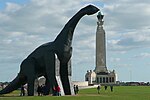Knight & Lee
Buildings and structures in PortsmouthDepartment store buildings in the United KingdomDepartment stores of the United KingdomJohn Lewis PartnershipOrganisations based in Portsmouth ... and 1 more
Use British English from August 2015

Knight & Lee was a department store in Southsea, Hampshire, England. The store was acquired by the John Lewis Partnership in 1933 and became the only provincial department store in the group not to trade under the John Lewis & Partners name. The shop officially closed on 13 July 2019. The proceeds from the sale of the freehold would be used to bring down the group's pension fund deficit.
Excerpt from the Wikipedia article Knight & Lee (License: CC BY-SA 3.0, Authors, Images).Knight & Lee
Clarendon Road, Portsmouth Southsea
Geographical coordinates (GPS) Address Phone number Website Nearby Places Show on map
Geographical coordinates (GPS)
| Latitude | Longitude |
|---|---|
| N 50.785 ° | E -1.0883 ° |
Address
Seeded
Clarendon Road 5
PO5 2DU Portsmouth, Southsea
England, United Kingdom
Open on Google Maps










